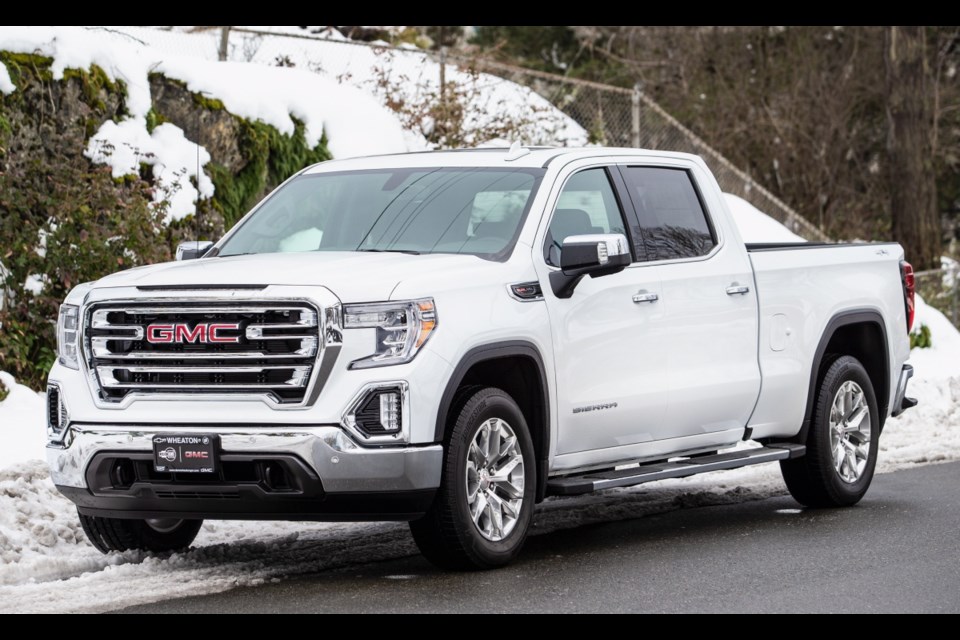It’s probably redundant to say “Go big or go home” to the 2019 GMC Sierra.
The phrase is an exhortation to go all out in life, sports — and in this case, a full-size pickup truck.
Sales of pickup trucks are a barometer of the economy. When the economy is hot, the segment fires on all cylinders. The pickup truck segment has grown almost 50 per cent between 2012 and 2017. Pickups represent 20 per cent of the overall Canadian market, accounting for roughly 400,000 units in 2018.
Pickups are also more profitable than passenger cars, so manufacturers have a vested interest to keep sales going.
The 2019 GMC Sierra is the result of these market forces.
I drove a Sierra 1500 SLT Crew Cab 4x4 with a base price of $58,500.
Unless you have been living under a rock for the past 50 years, you are probably well aware that there are literally hundreds of models, packages, engines and options when you decide on a truck. Just in the Sierra, you have six trim levels — from a 4x2 extended-cab pickup for $36,200 all the way up to a Denali 4x4 Crew Cab for $68,200.
GMCs are more popular than Chevrolets in Canada, but it is useful to know that the Chevy Silverado is the Sierra’s twin. While they share similar mechanicals under the skin, trim levels are different.
The Sierra’s biggest competitors are the Ford F-150 and the Ram 1500. All are full-size vehicles with half-ton payload (light duty) capability.
The completely redesigned 2019 is the fourth generation of the Silverado/Sierra, which debuted in 1999 (General Motors traces its first trucks back to the 1930s).
The redesign is just in time. While the previous-generation Sierra wasn’t past its prime, GM was forced to accelerate its introduction due to new offerings by Ford and Ram in recent years. Did I mention that this is probably the most competitive segment of the market?
Styling is, of course, subjective. The new grille still looks bold, but now more contemporary, with designers getting more creative with signature LED daylight running lights/headlights and fog lights.
Changes under the sheetmetal are more substantial, with GMC claiming to have shaved more than 160 kilograms off the curb weight. The boxed steel frame is lighter by 40 kilograms and extensive use of aluminum — for the hood, tailgate and doors — accounts for the rest.
Unlike Ford, GM decided not to go all-out and give the Sierra an all-aluminum cab and box.
Passengers in the crew cab benefit from more legroom, thanks to a longer wheelbase. Even the cargo box sees an increase in volume, thanks to a 220-millimetre addition to its width.
Just for your reference, there are four cab and bed configurations: Regular cab with long box; double cab with standard box; crew cab with short box and the crew cab with standard box.
There are four engine choices: a 6.2-litre V-8 with a 10-speed automatic transmission; 5.3-litre V-8 with eight-speed auto; 2.7-litre turbo four (yes, you read that right) cylinder with eight-speed auto and an all-new 3.0-litre turbodiesel (an inline six) coupled with the 10-speed auto due later in the summer.
My tester came with the 5.3-litre V-8, which produces 355 horsepower and 383 pound-feet of torque.
If you tow (probably one of the top reasons for buying a full-size truck), you will be happy to know that, properly equipped, you can trailer up to 5,534 kilograms (12,200 lbs.).
Niceties include high-resolution integrated cameras to give you a bird’s-eye view, including a Hitch View to help guide you to the hitch. A lighting option adds a pin light to assist the chore at night.
This year, GM has gone one step further — introducing an accessory camera that is meant to be mounted on the back of the trailer you are pulling. Real-time images from the camera appear on the truck’s centre screen, making the trailer virtually disappear behind you.
An in-vehicle trailering app allows drivers to enter their trailer profiles, run diagnostics, check trailer tire pressure and testing for lights.
The Sierra comes with an auto electric parking brake. It applies the parking brake once you put the vehicle in Park. What this does, when you are lining up the truck with the hitch, is to stop the truck from moving once you have aligned the two. I know, you can do so manually, but this is a nice touch.
The SLT and higher models boasts what GMC calls their MultiPro tailgate, with six modes. It is the upper quarter of the gate serving different functions — all with a mind to improving access to your load, helping you gain access to the bed or even creating a small work surface. In the future you will also be able to integrate a pair of speakers into it.
GM trucks have had steps carved into the corners of the rear bumper for a few years now. In 2019 the footwells are larger (for those with larger feet no doubt).
Next up will be an optional carbon-fibre bed to drive down weight even further.
The 2019 GMC Sierra is like a Swiss Army knife, with features that make life easier — but harder for the competition.
The spec sheet
Type: Full-size four-door pickup, front engine, 4x4
Engine: 5.3-litre V-8, 355 hp at 5,600 r.p.m., 383 lb.-ft. of torque at 4,100 r.p.m.
Transmission: Eight-speed automatic
Dimensions (mm): Length, 6,128; width, 2,063; height, 1,918; wheelbase, 5,886, box, 1,776
Curb weight (kg): 2,233
GVWR (kg): 3,221
Price (base/as tested): $58,500/$60,395 (includes $1,795 freight and PDI and $100 AC tax)
Options: Nil
Tires: 265/70 R17 all-season on alloy wheels
Fuel type: Regular
Fuel economy (L/100km): 15.3 city/ 11.2 highway
Warranty: Three years/60,000 km new car, five years/100,000 km powertrain and roadside assistance



